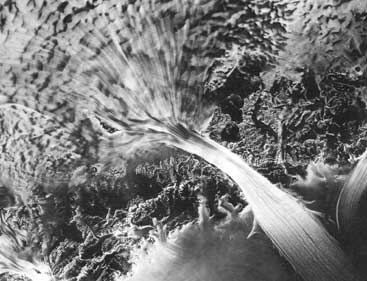Principal Investigators: Terence Hughes, Roger LeB. Hooke, James Fastook
We propose to study Byrd Glacier as a rock-floored ice stream that ends as a calving ice shelf. Our proposed study would be in two phases. Phase 1 is a one-year study devoted primarily to conceptual planning. Phase 2 is a two-year study that executes the plan. Funding is requested for Phase 1. Our proposed research is a contribution to assessing the hazards of recent giant iceberg calving to NSF Antarctic research dependent on McMurdo Station, and to planning ice-stream studies for the West Antarctic Ice Sheet Initiative (WAIS). Field studies on WAIS ice streams are unlikely until South Pole Station is rebuilt, which in turn depends on logistics from McMurdo Station.
Research would concentrate on acquiring additional data for Byrd Glacier and its flowband in order to investigate the dynamics of a rock-floored ice stream (fast glacier) and its floating extension to the calving front of the Ross Ice Shelf. Our goal is to include these flow and calving dynamics in ice-sheet models.

To attain our objectives, we require maps of surface elevation, ice thickness, internal radio-echo horizons, and bed topography for Byrd Glacier, for converging ice flow at its head, for possible grounding along lateral rifts at its foot, and for tracking bottom crevasses along its floating flowband to the calving front. These data must await renewal or replacement of the NSF contract with SOAR. We also require maps of surface velocities obtained from Landsat imagery and SAR interferometry by Baerbel Lucchitta and Christine Rosanova (USGS) and by Douglas MacAyeal (University of Chicago) for moving crevasses in these regions. In addition, we will need to establish and survey a stake network along the Byrd Glacier flowband to measure strain rates, and hence infer stress distribution, in order to determine how giant icebergs originate and how they calve. All of these data will be used (1) to reconcile different approaches to force-balance analysis, (2) to gain understanding of Byrd Glacier as a rock-floored ice stream, and (3) to investigate formation of bottom crevasses, crevasse transport to the calving front, and release of giant icebergs along these crevasses. Phase I work will focus on conceptual development regarding the above goals of our proposed study and planning field studies designed to attain these goals. Phase II work will focus on application of Phase I results to conducting field studies on Byrd Glacier as a rock-floored ice stream that nucleates crevasses along which giant icebergs eventually calve.
The graduate education and educational outreach contributions at the end of Phase 2 of our study will consist of training two graduate students and producing a video for public television and for our Internet site, including a student-interactive version for high school science classes. Using results from our modeling, the video would simulate (1) disintegration of the Ross Ice Shelf by releasing giant icebergs, (2) retreat of the Ross Ice Shelf grounding line up Byrd Glacier fjord through the Transantarctic Mountains, (3) retreat of the head of Byrd Glacier into the East Antarctic Ice Sheet. Removing the ice shelf may give Byrd Glacier the fourfold higher velocity of Thwaites Glacier. Removing the headwall may allow Byrd Glacier to downdraw more ice by lengthening and widening like West Antarctic ice streams supplying the Ross Ice Shelf and East Antarctic ice streams supplying the Filchner Ice Sheet.
